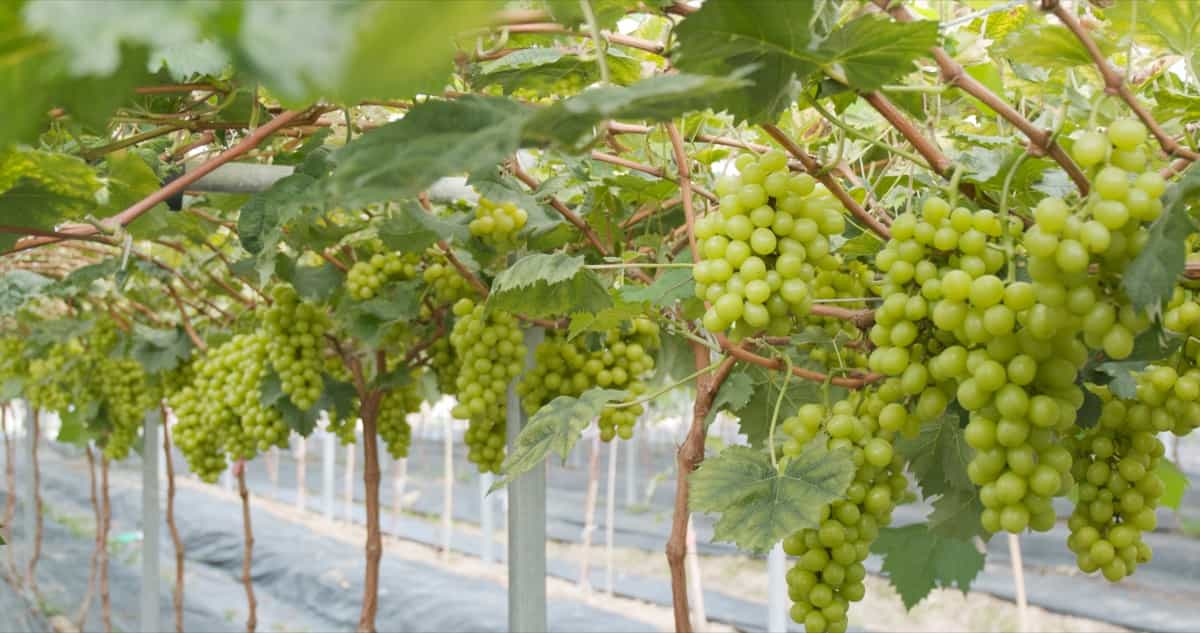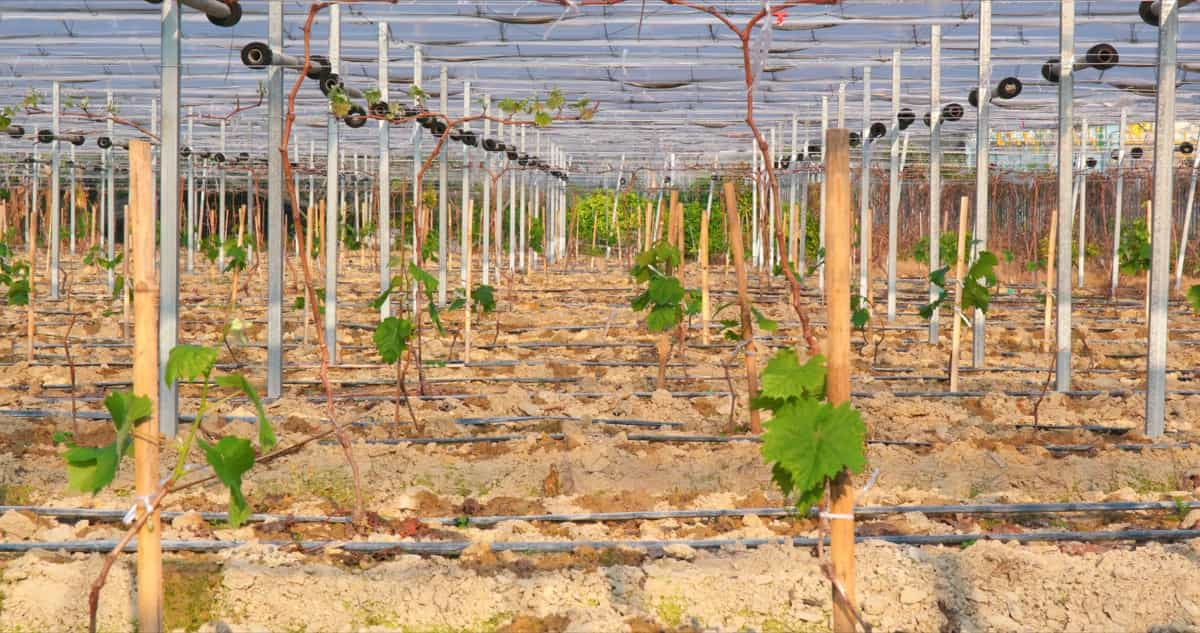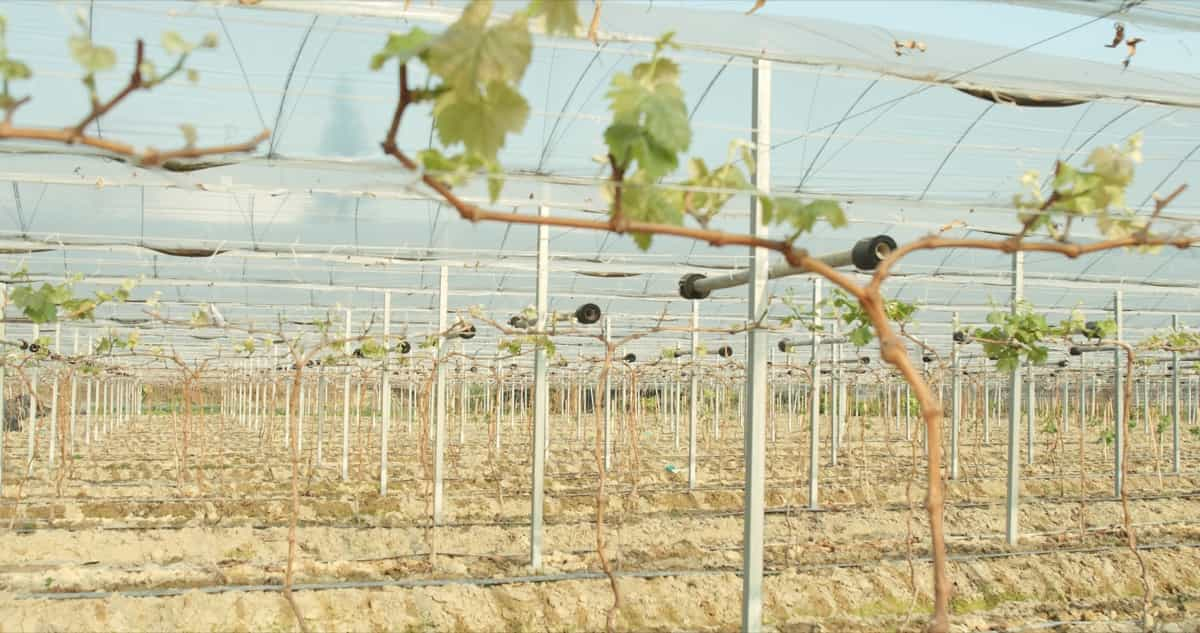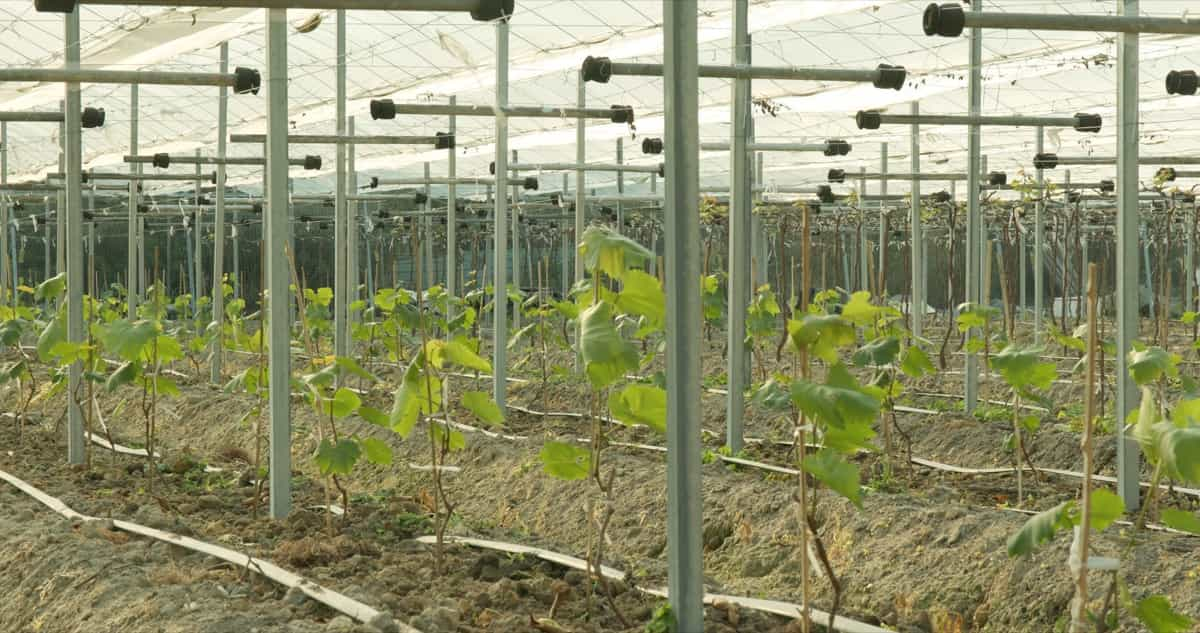The pandal system of training is a method of growing vines on overhead arbors or bowers, which are supported by pillars and wires. It is widely used in India for cultivating grapes and other horticultural crops, such as passion fruit, kiwi, dragon fruit, etc. In this article, we will discuss the definition and explanation of the pandal system of training, the factors affecting its cost per acre in India, and the different types of pandal systems.

We’ll also cover the benefits and challenges of using this method, the comparative analysis with other training methods, the economic analysis of its cost-benefit ratio, the government initiatives and subsidies supporting it, the best practices for implementing it, the impact of this system on crop yield and quality, the environmental implications and sustainability of this system, and the future trends in this system in India.
Definition and Explanation of Pandal System of Training
The pandal system of training is a method of growing vines on overhead arbors or pavilions, which are supported by pillars and wires. The pillars can be made of stone, cement, iron, bamboo, or live stakes of trees. The wires can be made of galvanized iron or bamboo. The height of the pavilions can vary from 1.8 to 3 meters, depending on the crop and the climate.
The spacing between the pillars can range from 3 to 6 meters, depending on the vigor of the vines. The spacing between the wires can be 30 to 45 cm, forming a network that covers the entire area. The vines are planted at a distance of 1.5 to 3 meters from each other and trained to reach the bower level by pinching or pruning the main stem. Then, two to four side shoots are allowed to grow from each vine and trained on either side or on four sides of the trunk to form arms.
These arms are allowed to reach the periphery of the bower and then tipped. On these arms, secondary branches are produced and spaced at intervals of 45 cm from each other alternately in opposite directions. These branches are trained to cover the framework uniformly. These secondary branches give rise to tertiary branches on which canes develop and produce shoots carrying bunches.
Factors Affecting the Cost of Pandal System of Training per Acre in India
- The type and quality of materials used for erecting the bower structure.
- The labor cost for planting, training, pruning, harvesting, and maintaining the vines.
- The cost of inputs such as fertilizers, irrigation, pesticides, etc.
- The type and variety of crops grown.
- The yield and quality of crops produced.
- The market price and demand for crops.
In case you missed it: Krishi Vigyan Kendra Schemes (KVKs) and Training in India

The cost of a pandal system of training per acre for grapes in India can range from Rs. 1.5 lakh to Rs. 2 lacks for erecting the bower structure, Rs. 50,000 to Rs. 1 lakh for planting material, Rs. 50,000 to Rs. 1 lakh for the labor cost per year, Rs. 50,000 to Rs. 1 lakh for inputs per year, and Rs. 10,000 to Rs. 20,000 for miscellaneous expenses per year.
Different Types of Pandal Systems in India
- Square pandal: This is a simple and common type of pandal system where the bower structure is square-shaped with four pillars at each corner and wires forming a square grid on top.
- Rectangular pandal: This is similar to a square pandal but with a rectangular shape and more pillars along the longer sides.
- Hexagonal pandal: This is a type of pandal system where the bower structure is hexagonal-shaped, with six pillars at each vertex and wires forming a hexagonal grid on top.
- Circular pandal: This is a type of pandal system where the bower structure is circular-shaped, with one pillar at the center and wires radiating from it to form a circular grid on top.
- Single-arm pandal: This is a type of pandal system where each vine has only one arm trained in one direction along the wires.
- Double-arm pandal: This is a type of pandal system where each vine has two arms trained in opposite directions along the wires.
- Four-arm pandal: This is a type of pandal system where each vine has four arms trained in four directions along the wires.
- Zig-zag pandal: This is a type of pandal system where the wires are arranged in a zig-zag pattern on the bower structure, and the vines are trained accordingly.
Benefits of Using the Pandal System of Training in Agriculture
- It allows for high productivity and quality of crops by providing adequate sunlight, air circulation, and space for the vines to grow and bear fruits.
- It facilitates multiple cropping and intercropping by allowing different crops to be grown in the same area under the bower structure.
- It reduces pest and disease incidence by keeping the vines away from the soil and improving the sanitation and hygiene of the crop.
- It reduces water loss and soil erosion by providing shade and mulch for the soil and conserving moisture and nutrients.
- It enhances the aesthetic appeal and recreational value of the farm by creating a beautiful and pleasant environment.
Challenges and Limitations of Implementing Pandal System of Training
- It requires high initial investment, maintenance costs for erecting and repairing the bower structure and training and pruning the vines.
- It requires skilled labor and technical knowledge to manage the crop and ensure proper growth and development of the vines.
- It may cause shading and competition among the vines and between different crops if not managed properly.
- It may need help in harvesting, transporting, and marketing the crops due to their large size and weight.
- It may have negative impacts on biodiversity and wildlife by altering the natural habitat and ecosystem.
Comparative Analysis: Pandal System vs. Other Training Methods in Agriculture
The pandal system of training can be compared with other training methods in agriculture based on the type and level of support provided for the vines, the shape and direction of growth of the vines and the advantages and disadvantages of each method.
In case you missed it: Grapes Training Systems and Methods: A Comparative Analysis

Examples of Other Training Methods
Head training: This is a method of growing vines on short stakes or posts without any wires or trellis. The vines are pruned to form a short trunk with few branches. This method is suitable for dry regions with low rainfall and low vigor varieties. The advantages are low cost, easy management, and early bearing. The disadvantages are low yield, poor quality, high pest and disease incidence, and high water loss.
Cordon training: This is a method of growing vines on horizontal wires or trellis supported by posts. The vines are pruned to form a long trunk with one or more horizontal arms. This method is suitable for humid regions with high rainfall and high-vigor varieties. The advantages are high yield, good quality, low pest and disease incidence, and low water loss. The disadvantages are high cost, difficult management, and late bearing.
Kniffin system: This is a method of growing vines on vertical wires or trellis supported by posts. The vines are pruned to form a short trunk with two or more vertical arms. This method is suitable for temperate regions with moderate rainfall and moderate vigor varieties. The advantages are moderate yield, good quality, moderate pest and disease incidence, and moderate water loss. The disadvantages are moderate cost, moderate management, and moderate bearing.
Economic Analysis: Cost-Benefit Ratio of Pandal System of Training per Acre
The cost-benefit ratio of the pandal system of training per acre can be calculated by comparing the total cost incurred for implementing this method with the total revenue generated from selling the crops produced by this method.
The total cost can include
- The fixed cost for erecting the bower structure
- The variable cost for planting material, labor, inputs, etc.
The total revenue can include
- The gross income from selling the crops
- The net income after deducting the marketing expenses
- The cost-benefit ratio can be expressed as:
- Cost-benefit ratio = Total revenue / Total cost
- A higher cost-benefit ratio indicates a higher profitability of this method.
The cost-benefit ratio of the pandal system of training per acre for grapes in India can range from 1.5 to 2.5 lakhs depending on the variety, yield, quality, price, etc.
Government Initiatives and Subsidies Supporting Pandal System of Training
India’s Ministry of Agriculture, Farmers Welfare has launched several schemes to support farmers adopting the pandal system of training for horticultural crops, particularly grapes. These include the Mission for Integrated Development of Horticulture (MIDH), which provides subsidies for various components such as planting material, drip irrigation, fertigation, and trellis.
In case you missed it: Polyhouse Farming in India: Training, Cost, Equipment, Subsidy, and Techniques

The National Horticulture Board (NHB) also offers credit-linked back-ended subsidies for capital investment in horticulture projects, including the pandal system of training for grapes. The National Food Security Mission aims to increase food crop production and productivity through area expansion, soil fertility restoration, employment opportunities, and farm-level economy. The Rashtriya Krishi Vikas Yojana (RKVY) incentivizes states to increase investment in agriculture and allied sectors, promoting the pandal system of training for horticultural crops.
Best Practices for Implementing Pandal System of Training in India
The pandal system of training is a method of growing plants that requires careful planning and execution. It involves selecting a suitable site with good soil fertility, drainage, irrigation facilities, sunlight exposure, and protection from strong winds and frost. The chosen variety should be compatible with climatic conditions, market demand, pest and disease resistance, and yield potential. The planting material should be healthy, disease-free, and true to type, with cuttings or rooted cuttings preferred over grafts or layers.
The layout and spacing should be designed according to the pandal structure’s shape and size, with a spacing of 3X3 m and 4X4 m. The pandal structure should be sturdy, durable, and economical, with wires or strips arranged in a grid pattern. The main stem should be trained vertically, followed by pinching to induce lateral branches or arms. Secondary branches or tertiaries should be spaced at intervals of 45 cm, producing fruiting canes that bear clusters. Pruning is done to regulate vegetative growth and fruiting potential.
Impact of Pandal System on Crop Yield and Quality
- It increases the productivity per unit area by utilizing the vertical space and allowing higher plant density.
- It improves the quality of fruits by providing uniform sunlight exposure, air circulation, and pest and disease management.
- It facilitates the harvesting and post-harvest handling of fruits by reducing damage and losses.
- It extends the cropping season by enabling multiple harvests in a year.
The pandal system of training can increase the yield of grapes by 30-40% compared to the conventional system. The study also reported that the pandal system can improve the quality parameters of grapes, such as size, shape, color, sugar content, and shelf life.
Environmental Implications and Sustainability of Pandal System in Agriculture
The use of pandal training for crop cultivation requires more water and fertilizer due to its higher plant density and vigor. It may cause soil erosion and nutrient leaching, increase carbon footprint and greenhouse gas emissions due to non-biodegradable materials, and pose a threat to biodiversity and ecosystem services.
To address these challenges, adopt drip irrigation and fertigation systems, apply organic mulches to conserve soil moisture and fertility, use biodegradable materials like bamboo, wood, or coir, and practice crop rotation, intercropping, or mixed cropping to diversify the cropping system and enhance ecological balance.
Future Trends in the Pandal System of Training in India
The pandal system of training is expected to gain popularity and acceptance among farmers and consumers in India in the future due to factors such as increasing demand for high-quality horticultural products, awareness of health benefits, nutritional value of horticultural crops, availability of improved varieties, technologies, and inputs, and government policies supporting the pandal system. Challenges include:
- High initial investment and maintenance costs.
- Lack of skilled labor and technical expertise.
- Climatic risks.
- Social and cultural barriers.
In case you missed it: Hydroponic Farming in Hyderabad: Setup Cost, Training, Companies, and Equipment Suppliers

The cost per acre for establishing and operating a pandal system of training for different horticultural crops in India may vary depending on factors such as region, variety, material, and labor. However, the pandal system is expected to gain more acceptance and support from farmers and consumers.
Pandal System of Training Cost Per Acre in India
The pandal system is suitable for many gourd vegetables, such as bitter gourd, ribbed gourd, snake gourd, lab-lab, chow-chow, coccinea, bottle gourd, etc. It can also be used for fruits like grapes and musk melon. The pandal system requires an initial investment in erecting the pillars and wires, which can be made of cement, stone, or iron. The height of the pillars should be about 10 feet, and the spacing should be about 15×15 m. The wires should be spaced at 30×45 cm or 30×30 cm intervals, forming a network.
| Crop | Cost Per Acre (in Rs.) |
| Bitter gourd | 1,00,000 |
| Ribbed gourd | 1,00,000 |
| Snake gourd | 1,00,000 |
| Lab-lab | 1,00,000 |
| Chow-chow | 1,00,000 |
| Coccinea | 1,00,000 |
| Bottle gourd | 1,00,000 |
| Grapes | 2,50,000 |
| Musk melon | 1,50,000 |
| Passion fruit | 2,00,000 |
| Kiwi fruit | 3,00,000 |
| Dragon fruit | 2,50,000 |
| Vanilla | 2,50,000 |
| Betel vine | 3,00,000 |
| Black pepper | 2,50,000 |
The pandal system is a proven technology that can enhance the profitability of gourd and other horticultural crops. Farmers in Tamil Nadu and other states of India widely adopt it.
In case you missed it: Fertilizers Cost Per Acre: Analysis of Government Subsidies on Fertilizers in India

Conclusion
This comparative analysis reveals intriguing insights into the Pandal System of Training Cost Per Acre in India for diverse horticulture crops. The data underscores the varying financial implications, empowering farmers and stakeholders with valuable information for informed decision-making in optimizing cultivation practices and economic returns.
- Types of Pesticides Used in Agriculture: A Beginner’s Guide
- Economical Aquaculture: A Guide to Low-Budget Fish Farming
- 15 Common Planting Errors That Can Doom Your Fruit Trees
- How to Make Houseplants Bushy: Effective Tips and Ideas
- Innovative Strategies for Boosting Coconut Pollination and Yield
- Pollination Strategies for Maximum Pumpkin Yield
- The Complete Guide to Chicken Fattening: Strategies for Maximum Growth
- Natural Solutions for Tulip Problems: 100% Effective Remedies for Leaf and Bulb-Related Issues
- Revolutionizing Citrus Preservation: Towards a Healthier, Greener Future
- Natural Solutions for Peony Leaf and Flower Problems: 100% Effective Remedies
- Maximizing Profits with Avocado Contract Farming in India: A Comprehensive Guide
- Natural Solutions for Hydrangea Problems: 100% Effective Remedies for Leaf and Flowers
- The Ultimate Guide to Choosing the Perfect Foliage Friend: Bringing Life Indoors
- From Sunlight to Sustainability: 15 Ways to Use Solar Technology in Agriculture
- The Ultimate Guide to Dong Tao Chicken: Exploring from History to Raising
- The Eco-Friendly Makeover: How to Convert Your Unused Swimming Pool into a Fish Pond
- Mastering the Art of Delaware Chicken Farming: Essentials for Healthy Backyard Flocks
- 20 Best Homemade Fertilizers for Money Plant: DIY Recipes and Application Methods
- How to Craft a Comprehensive Free-Range Chicken Farming Business Plan
- Brighten Your Flock: Raising Easter Egger Chickens for Beauty and Bounty
- How to Optimize Your Poultry Egg Farm Business Plan with These Strategies
- Subsidy for Spirulina Cultivation: How Indian Government Schemes Encouraging Spirulina Farmers
- Ultimate Guide to Raising Dominique Chickens: Breeding, Feeding, Egg-Production, and Care
- Mastering the Art of Raising Jersey Giant Chickens: Care, Feeding, and More
- Ultimate Guide to Raising Legbar Chickens: Breeding, Farming Practices, Diet, Egg-Production
- How to Raise Welsummer Chickens: A Comprehensive Guide for Beginners
- How to Protect Indoor Plants in Winter: A Comprehensive Guide
- Ultimate Guide to Grow Bag Gardening: Tips, Tricks, and Planting Ideas for Urban Gardeners
- Guide to Lotus Cultivation: How to Propagate, Plant, Grow, Care, Cost, and Profit
- Agriculture Drone Subsidy Scheme: Government Kisan Subsidy, License, and How to Apply Online
- Ultimate Guide to Raising Araucana Chickens: Breed Profile, Farming Economics, Diet, and Care
- Bringing Hydroponics to Classroom: Importance, Benefits of Learning for School Students
- Ultimate Guide to Raising Polish Chickens: Breed Profile, Farming Economics, Diet, and Care
- Ultimate Guide to Raising Australorp Chickens: Profile, Farming Economics, Egg Production, Diet, and Care
- Silkie Chicken Farming: Raising Practices, Varieties, Egg Production, Diet, and Care
- Sussex Chicken Farming: Raising Practices, Varieties, Egg Production, Diet and Care